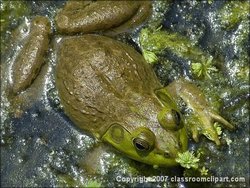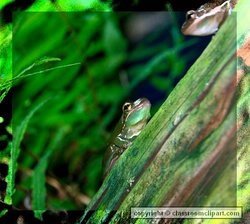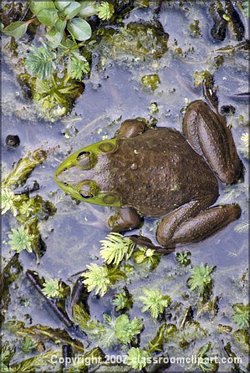Amphibian
|
|
| Amphibians | ||||||||
|---|---|---|---|---|---|---|---|---|
| Scientific classification | ||||||||
| ||||||||
| Orders | ||||||||
|
Subclass Labyrinthodontia - extinct |
Amphibians (class Amphibia) are a group of animals that include all tetrapods (four-legged vertebrates) that do not have amniotic eggs. Amphibians (from Greek amphis "both" and bios "life") generally spend part of their time on land, but they do not have the adaptations to an entirely terrestrial existence found in most other modern tetrapods (amniotes). There are about 5,700 living species of amphibians.
| Contents |
History of amphibians
Amphibians developed with the characteristics of pharyngeal slits/gills, a dorsal nerve cord, a notochord, and a post-anal tail at different stages of their life. They have persisted since the dawn of tetrapods 390 million years ago in the Devonian period, when they were the first four-legged animals to develop lungs. During the following Carboniferous period they also developed the ability to walk on land to avoid aquatic competition and predation while allowing them to travel from water source to water source. As a group they maintained the status of the dominant animal for nearly 75 million years. Throughout their history they have ranged in size from the 15 foot long Devonian Ichthyostega, to the slightly smaller 6 foot long Eryops, and down to the tiny 1 centimeter long Psyllophryne didactyla, commonly known as the Brazilian Gold Frog. Amphibians have mastered almost every climate on earth from the hottest deserts to the frozen arctic, and have adapted to climatic change with ease.
Classification
Traditionally the amphibians are taken to include all tetrapods that are not amniotes. Recent amphibians all belong to a single subgroup of these, called the Lissamphibia. Recently there has been a tendency to restrict the class Amphibia to the Lissamphibia, i.e. to exclude tetrapods that are not more closely related to modern forms than they are to modern reptiles, birds, and mammals.
There are two ancient, extinct, subclasses:
- Subclass Labyrinthodontia
- Subclass Lepospondyli
Of the remaining modern subclass Lissamphibia there are three orders:
- Order Anura (frogs and toads) (in Superorder Salientia): 5,070 species
- Order Caudata or Urodela (salamanders): 510 species
- Order Gymnophiona or Apoda (caecilians): 170 species
Authorities disagree on whether Salientia is a Superorder that includes the order Anura, or whether Anura is a sub-order of the order Salientia. In effect Salientia includes all the Anura plus a single Triassic proto-frog species, Triadobatrachus massinoti. Practical considerations seem to favour using the former arrangement now.
Reproduction
For the purpose of reproduction all amphibians are bound to water. Several species have adapted to arid and semi-arid environments, but most of them need water to lay their eggs. The larvae breathe with exterior gills. After hatching they start to transform gradually to the adult's appearance. This process is called metamorphosis. Typically, the animals then leave the water and become terrestrial adults, but there are some exceptions to this general way of reproduction.
The most obvious part of the amphibian metamorphosis is the formation of four legs in order to support the body on land. But there are several other changes:
- The gills are replaced by other respiratory organs, e.g. lungs.
- The skin changes and develops glands to avoid dehydration
- The eyes get eyelids and adapt to vision outside the water
- An eardrum is developed to lock the middle ear
Clipart and Animal Pictures
- Clipart (https://classroomclipart.com/image/category/clipart.htm)
- Animal Clipart (https://classroomclipart.com/image/category/animal-clipart.htm)
- Animal Animated Clipart (https://classroomclipart.com/clipart/Animations/Animals.htm)
- Pictures of Animals (https://classroomclipart.com/image/category/animal-photos.htm)
- Amphibian Clip Art, Pictures and Photogaphs (https://classroomclipart.com/image/category/amphibian-clipart.htm)
- Farm Animal Clip Art, Pictures and Photographs (https://classroomclipart.com/image/category/farm-animal-clipart.htm)
- Mammal Clip Art, Pictures and Photographs (https://classroomclipart.com/image/category/mammal-clipart.htm)
- Marine Animal Clip Art, Pictures and Photographs (https://classroomclipart.com/image/category/marine-life-clipart.htm)
- Reptile Clip Art, Pictures and Photographs (https://classroomclipart.com/image/category/reptile-clipart.htm)
- Spider Clip Art, Pictures and Photographs (https://classroomclipart.com/image/category/spider-clipart.htm)




